ATHENS
Acropolis
Athena Nike
Erechtheum
Parthenon
Propylaia
Acropolis
Museum
South
Slope overview
South Slope lecture
Pnyx
Areopagus
Philopappos
Hill
Agora
Temple
of Olympian Zeus
and Arch of Hadrian
Keramikos
Roman Agora
ATTICA
Brauron
Thorikos
Sounion
Oropos
Marathon
Eleusis
Aigosthena/
Eleutherai
Daphni
Piraeus
MESSENIA
Pylos
Voidokilia
Methoni
Messene
CORINTHIA
Perachora
Corinth
Acrocorinth
Diolkos/Canal
Nemea
Isthmia
BOEOTIA
Thebes
Chaironeia
Orchomenos
Gla
Osios
Loukas
ARGOLID
Epidavros
Nauplion
Mycenae
Argos
Tiryns
ARCADIA
Megalopolis
Overview
Tegea
LACONIA
Mistras
Sparta
Monemvasia
ACHAEA
Kalavrita
NORTHERN
GREECE
scenery
Mount
Olympos
DELPHI
Thermopylae
Naupaktos
Mieza
Edessa
Vergina
Pella
Thessaloniki
ELEIA
Olympia
Chlemoutsi
SARONIC GULF ISLANDS
Aegina
Poros
Hydra
Spetses
CYCLADIC ISLANDS
Santorini
Delos
CRETE
Cnossos
Phaistos
Zakros
|
|
Dr.
J's Illustrated Temple of Athena Nike (427-424 BC) Lecture

The Temple of Athena Nike on the Nike Bastion. The temple is
amphiprostyle, with four Ionic columns each in front and behind the main
cella, designed
by the architect Kallicrates. Inside the cella would have stood the cult statue of Athena
holding a helmet in one hand and a pomegranate (symbol of fertility) in the other. |
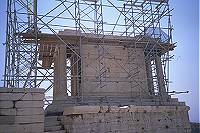
The Turks dismantled the temple in 1686, and it has been reassembled twice
since then. 1998's effort (note the scaffolding) is yet another step in restoring its
original beauty. |
 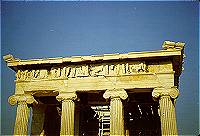
The frieze of the Temple of Athena Nike
depicts the
Battle of
Plataea, the victory of the Greeks over the Persians in 479 BC., a historical, not
mythological, art motif. Four of the original 14 slabs are now on display in the British
Museum (upper right).
|

As patron goddess, Athena merits the epithet Nike, or
"bringer of victory," but Nike is a winged goddess. Pausanias claims that the
Athenians worship a wingless - Apteros - Athena to prevent her from deserting the city and
taking away hope of future victories (this is not unlike the explanation that
the British
monarchy will fall once the ravens leave the Tower of London - thus each
bird has one winged clipped to frustrate flight edited
11/07/03). |
 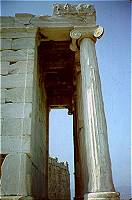
Temple of Athena Nike. Note the curved corner Ionic capital.
Surrounding the temple at its base (just visible in the left corner) was a marble parapet sculptured in high relief. This piece (photo on right) detailing Athena
adjusting her sandal belongs to this group dated to 410 BC (inset). |
|
Entryway to remains of 6th century temple, destroyed by the
Persians in 480 BC, directly beneath the Temple of Athena Nike. In the background is the
Aegean Sea, namesake of Aegeus, mythical king of Athens. Tradition has it that Aegeus
leapt into the sea after jumping to the wrong conclusion that his son Theseus had been
killed by the Minotaur, a monster he had sailed to Crete to dispatch (Theseus forgot to
change his sails from black to white). It is hardly likely, however, that Aegeus leapt
into the sea from here, no matter what Pausanias says (1.21.5). The alternate tale, which
gives Cape Sounion as the site of Aegeus' plunge, is much more likely. |
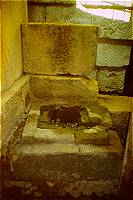 Directly below the Temple of Athena Nike lay the remains of an
earlier sixth century Temple to the same goddess. On the left is possibly the base of the
cult statue of Athena from that earlier temple. Lead was apparently poured into the base
to secure a statue. When Balanos found this base, it was covered over with stone and
filled with phi and psi statues
(Mycenean votives), representations perhaps of the cult figure
removed to safety. Directly below the Temple of Athena Nike lay the remains of an
earlier sixth century Temple to the same goddess. On the left is possibly the base of the
cult statue of Athena from that earlier temple. Lead was apparently poured into the base
to secure a statue. When Balanos found this base, it was covered over with stone and
filled with phi and psi statues
(Mycenean votives), representations perhaps of the cult figure
removed to safety.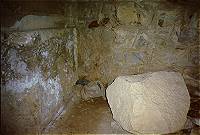 Offerings were also present in the form of food. On the right is
possibly a base for another statue of Athena, but this statue
would have been seated. This wall is really an extension of a
column that supports the corner of the Temple of Athena Nike
above. The Turks stored gunpowder in this crypt.
Offerings were also present in the form of food. On the right is
possibly a base for another statue of Athena, but this statue
would have been seated. This wall is really an extension of a
column that supports the corner of the Temple of Athena Nike
above. The Turks stored gunpowder in this crypt.
copyright
2001 Janice
Siegel,
All Rights Reserved
send comments to: Janice Siegel (jfsiege@ilstu.edu)
date this page was edited last:
08/02/2005
the URL
of this page:
|
|









